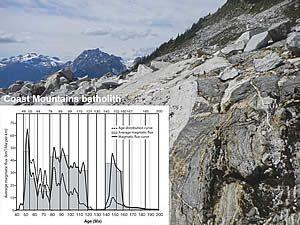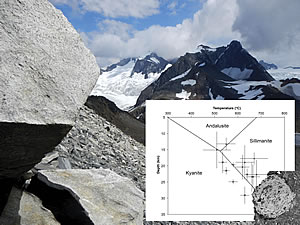Processes Controlling the Growth and Evolution of Continental Batholiths, Coast Mountains British Columbia, Canada
Conveners
Harold Stowell, Geological Sciences, University of Alabama, Tuscaloosa, Alabama, USA
Margaret Rusmore, Department of Geology, Occidental College, Los Angeles, California, USA
Glenn Woodsworth, Vancouver, British Columbia, Canada
Description and Objectives
 Figure 1. Magmatic flux rates for the northern Coast Mountains in British Columbia, Canada. Flux rates are from Gehrels et al. (2009). Photo by H. Stowell (click to enlarge).
Figure 1. Magmatic flux rates for the northern Coast Mountains in British Columbia, Canada. Flux rates are from Gehrels et al. (2009). Photo by H. Stowell (click to enlarge).
This five-day field forum will explore the growth and evolution of continental batholiths. Although comprehensive datasets are available for many batholiths (e.g., Sierra Nevada, California, USA; Peninsular Ranges, Baja California, Mexico; and Fiordland, New Zealand), the processes responsible for growth of large Cordilleran batholiths are still poorly understood. The Coast Mountains Batholith, British Columbia, is an ideal location for the field forum because it is the largest calc-alkaline plutonic complex on Earth. New data indicate that the batholith exhibits significant along-strike and cross-strike variations in structure, pluton compositions, and exhumation depths.
Magmatic arcs are the primary locations for production of continental crust; therefore, continental batholiths should reflect these processes. A growing body of data from upper and lower crustal exposure of batholiths around the globe indicate that most batholiths are comprised of plutons that are emplaced during relatively brief time periods (tens of millions of years) known as High Flux Events (HFE). These HFE punctuate the long history of magmatism in batholiths, resulting in HFE separated by low magmatic fluxes that may last up to 100 million years. HFE may be triggered by events external to the continental crust (e.g., subduction angle, age of subducting crust) or events internal to the continental crust (e.g., contraction or other crustal-scale rearrangement within the arc). HFE have been documented in the northern Coast Mountains batholith, and associated isotopic data suggest an increased signature from evolved continental crust during HFE. Recent research focuses on evaluating crustal contributions to batholith magmas in the central and southern Coast Mountains. One ongoing aspect of this research compares and contrasts the sources of magmas emplaced during HFE with those emplaced during low flux periods.
 Figure 2. Pressure and temperature estimates for metamorphism during garnet growth in the Mount Waddington area of the Coast Mountains, British Columbia, Canada. Data are from Elizabeth Bollen (unpublished). Photo by H. Stowell.
Figure 2. Pressure and temperature estimates for metamorphism during garnet growth in the Mount Waddington area of the Coast Mountains, British Columbia, Canada. Data are from Elizabeth Bollen (unpublished). Photo by H. Stowell.
The Thompson Field Forum will follow a transect across the Coast Mountains at the latitude of Prince Rupert, Canada. This transect studied extensively by the research group led by Lincoln Hollister, provides a window into the architecture of the batholith and the country rock, which preserve a record of batholith formation and emplacement during terrane accretion, crustal contraction and thickening, and extensional collapse. The Forum will introduce researchers to this spectacular geology and focus attention on areas where productive study can resolve outstanding questions, which begin with origin of the batholith. Regional maps coupled with large geochronological datasets delineate the broad framework of the batholith. Continuously exposed for >1500 km from south of Vancouver to north of Juneau, Alaska, the Coast Mountains Batholith consists of calc-alkaline, dioritic to granitic plutons ranging from early Jurassic to Eocene. Overall, plutons become younger toward the continent. Magmatic patterns define two arcs or a doubled arc prior to ~120 – 100 Ma. Built upon this broad framework, detailed investigations reveal a complex history of batholith growth that is not yet fully understood.
U-Pb zircon with complementary Hf and O isotope data combined with whole rock chemical and isotopic data identify HFE and indicate that magmas had larger crustal components during some of these events documented for the Bella Coola to Ketchikan segment of the batholith. Preliminary datasets for the batholith south of Bella Coola indicate along-strike changes that likely reflect fundamental variation in the magmatic system. Future work will evaluate the roles of transpression and transtension during formation of the batholith.
High-quality seismic profiles from the area of the Forum Transect yield a precise location of the present Moho and average lithologies through the crust based on the ratio of compressional to shear wave velocities (Vp/Vs). These data constrain crustal thickness to ~32 km beneath much of the batholith and clearly delineate a 5 km offset (shallower to the west) of the Moho at the Coast shear zone along the west side. Extensional collapse of the batholith, leading to formation of Hecate Strait and Queen Charlotte basin, is evident in marine geophysical transects. The Moho is ~35 km deep near Vancouver, and significant orogenic collapse is not apparent there, also indicating along-strike variation in the batholith.
Structural and metamorphic studies show that the batholith formed in a dynamic and variable tectonic regime that differed along its length. Understanding of the tectonics is complicated by Early Cretaceous sinistral transpression that altered the Jurassic to Early Cretaceous magmatic patterns. Subsequently, a large pulse of Late Cretaceous magma intruded during doubly vergent thrust faulting and dextral transpression. Metamorphic pressure-temperature-time (P-T-t) data linked with structural analysis indicate significant crustal thickening and local partial melting during the Late Cretaceous. Batholith growth continued during dextral transpression, potentially with large latitudinal translation. In the Prince Rupert area, crustal extension marked the end of batholith growth during the Eocene. Metamorphic P-T-t paths indicate rapid exhumation of granulite during this extension. Although this event was pronounced in the Prince Rupert and Ketchikan map-areas, it did not significantly affect the southern part of the batholith; it is not known if Eocene extension occurred north of Ketchikan.
In spite of the large datasets available for parts of the batholith, significant gaps in data limit understanding of the processes responsible for batholith growth. Most particularly, the apparent along-strike changes in the batholith can serve to illuminate processes affecting batholith growth. The forum will highlight these gaps and facilitate discussion of productive avenues for further research. Specific questions that will be addressed during the forum include: What drove changes in crustal thickness and how did these changes influence magmatic processes? What is the kinematic history of crustal-scale shear zones; is transcurrent slip a significant factor in development of the orogen? How do crustal-scale shear zones influence batholith formation? Did crustal deformation result from formation and intrusion of melts? What were the contributions of mantle and crust to the melts? What was the role of sediments to the generation of melts? What were the roles of metamorphism, assimilation, and contamination in forming melts? Did lithosphere delamination occur? Was there ridge subduction? Existing age data for the plutons require high magma flux events; what triggered these?
This Thompson Field Forum Will Emphasize:
- Critical evaluation of data diagnostic of HFE, using the Coast Mountains batholith as an example;
- Cross-disciplinary assessment of batholith structure;
- Factors contributing to HFE in the batholith;
- The role of external and internal mechanisms on batholith growth;
- Structural controls on the growth and architecture of batholiths; and
- The nature of metamorphism and its role in magmatism.
The Coast Mountains batholith is an ideal location for the field forum because exceptional exposure provides a window into the relevant scale of batholithic process. Existing datasets help define key problems and productive study sites. Superb exposures, fresh rock, and road-based access make the Prince Rupert transect an attractive field area. Most critically, insights into batholith formation, terrane accretion, and orogenic evolution can be gained from studies ranging from large, multidisciplinary collaborations to student-scale projects. The field forum will set the stage for researchers interested in investigating batholith formation and related orogenic processes in the Coast Mountains or elsewhere. The conveners, joined by Lincoln Hollister, look forward to seeing you there!
PRELIMINARY AGENDA
The forum will be based in hotels in Terrace and Prince Rupert, British Columbia. A few of the outcrops will require hiking in steep and very slippery terrain. The weather is likely to be wet and cool during the trip.
12 Aug., Arrivals & evening ice breaker;
13 Aug., Day 1: Stikine terrane & sedimentary basins on the eastern flank of the batholith;
14 Aug., Day 2: Shames River Detachment and the Ponder Pluton;
15 Aug., Day 3: High-grade migmatite, Kwinitsa Quarry, and Central Gneiss by helicopter;
16 Aug., Day 4: The western metamorphic belt: low grade to high grade;
17 Aug., Day 5: Kasiks, Quottoon, and Ecstall plutons along the western flank; wrap-up discussions and plans for future research and collaboration;
18 Aug., Departures.
ATTENDEES AND ESTIMATED COSTS
The registration fee will cover hotel lodging for six nights (double occupancy), breakfast, lunch, and snacks for six days, handouts, and transportation for the field trip. Airfare is not included, and participants must make their own travel arrangements. Registration fees have not been finalized. Please check this web page for updates.
APPLICATION & REGISTRATION
Application deadline: 31 January 2018
Registration deadline: 31 March 2018
Participants must commit to attending the full five days of the field conference. Group size will be limited to 30 participants.
To apply, please contact the conveners by emails to both and with a letter of intent that includes a statement of interests, the relevance of your recent work to the themes of the field conference, the subject of a proposed presentation, and contact information. Interested graduate students and early career faculty are strongly encouraged to apply. Once you have been selected to participate, you will be sent registration information. Please check the conference website for updates.